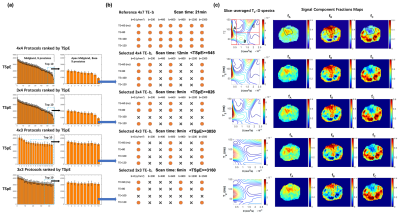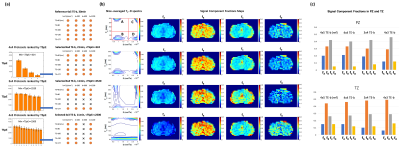Zhaohuan Zhang1, Sohrab Afshari Mirak1, Melina Hosseiny1, Afshin Azadikhah1, Amirhossein Mohammadian Bajgiran1, Alan Priester2, Kyunghyun Sung1, Anthony Sisk3, Robert Reiter2, Steven Raman1, Dieter Enzmann1, and Holden Wu1
1Department of Radiological Sciences, UCLA, Los Angeles, CA, United States, 2Department of Urology, UCLA, Los Angeles, CA, United States, 3Department of Pathology, UCLA, Los Angeles, CA, United States
1Department of Radiological Sciences, UCLA, Los Angeles, CA, United States, 2Department of Urology, UCLA, Los Angeles, CA, United States, 3Department of Pathology, UCLA, Los Angeles, CA, United States
Using a data-driven systematic framework to select subsampling schemes, we demonstrated ~60% reduction in scan time for prostate DR-CSI while maintaining accurate prostate microstructure parameter estimation. This framework may benefit design of accelerated DR-CSI for PCa diagnosis.

Figure 3: (a) Evaluation of subsampled TE-b schemes for ex vivo prostate DR-CSI. For a fixed total encoding number, each TE-b scheme was compared to the reference 4x7 scheme in terms of the mean total spectrum error (TSpE) in 9 prostates. (b) Selected schemes with the minimum mean TSpE (c) Slice-averaged T2-D spectra and signal component fraction maps from each schemes. The definitions of the three spectral peaks are indicated on the reference T2-D spectrum. The prostate cancer region of interest (transition zone) is denoted by the black contour on the reference (fA,, fB, fC) maps.

Figure 5: (a) Evaluation of subsampled TE-b schemes for in vivo prostate DR-CSI. For a fixed total encoding number, each TE-b scheme was compared to the reference 5x4 scheme in terms of the mean total spectrum error (TSpE) . (b) Slice-averaged T2-D spectra and signal component fraction maps from each selected schemes. The definitions of the four spectral peaks are indicated on the reference T2-D spectrum (c) Evaluation of signal component fraction estimates in the overall prostate peripheral zone (PZ) and transition zone (TZ). compared to reference